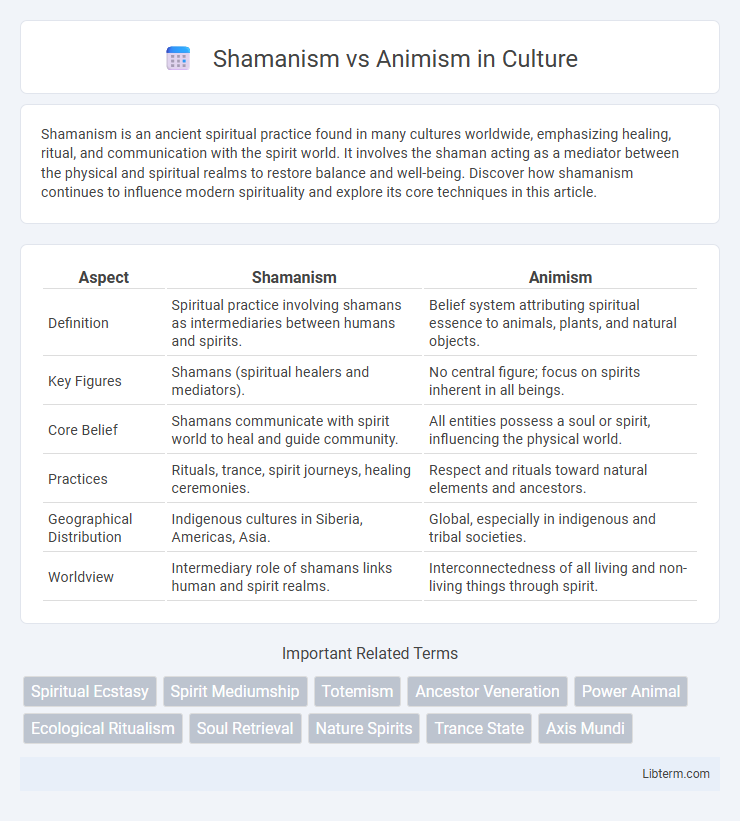Shamanism is an ancient spiritual practice found in many cultures worldwide, emphasizing healing, ritual, and communication with the spirit world. It involves the shaman acting as a mediator between the physical and spiritual realms to restore balance and well-being. Discover how shamanism continues to influence modern spirituality and explore its core techniques in this article.
Table of Comparison
| Aspect | Shamanism | Animism |
|---|---|---|
| Definition | Spiritual practice involving shamans as intermediaries between humans and spirits. | Belief system attributing spiritual essence to animals, plants, and natural objects. |
| Key Figures | Shamans (spiritual healers and mediators). | No central figure; focus on spirits inherent in all beings. |
| Core Belief | Shamans communicate with spirit world to heal and guide community. | All entities possess a soul or spirit, influencing the physical world. |
| Practices | Rituals, trance, spirit journeys, healing ceremonies. | Respect and rituals toward natural elements and ancestors. |
| Geographical Distribution | Indigenous cultures in Siberia, Americas, Asia. | Global, especially in indigenous and tribal societies. |
| Worldview | Intermediary role of shamans links human and spirit realms. | Interconnectedness of all living and non-living things through spirit. |
Defining Shamanism and Animism
Shamanism is a spiritual practice centered around a shaman who acts as an intermediary between the human world and the spirit realm, often engaging in healing, divination, and ritualistic ceremonies. Animism is a belief system that perceives all living beings, natural objects, and phenomena as possessing a spiritual essence or consciousness. While shamanism involves specific roles and practices to connect with spirits, animism broadly underpins the worldview that everything in nature is alive and spiritually significant.
Historical Origins and Development
Shamanism originated primarily in Central Asia during the Upper Paleolithic period, characterized by individuals believed to mediate between the human world and spirits through trance rituals, healing, and divination practices. Animism, often regarded as the earliest form of religion, traces its roots to prehistoric times across various indigenous cultures worldwide, emphasizing the belief that all natural entities, including animals, plants, and inanimate objects, possess a distinct spiritual essence. Both belief systems evolved through oral traditions and ritualistic practices, with shamanism developing as a specialized spiritual role within animistic frameworks, reflecting complex social and ecological interactions over millennia.
Core Beliefs and Worldviews
Shamanism centers on the belief that shamans act as intermediaries between the human and spirit worlds, facilitating healing and guidance through trance journeys and rituals. Animism holds that all entities--animals, plants, rocks, and natural phenomena--possess a spiritual essence, creating an interconnected and conscious universe. Both worldviews emphasize a profound respect for nature, but Shamanism highlights active spiritual intervention, while Animism focuses on universal spiritual presence.
Spiritual Practices and Rituals
Shamanism involves practicing spiritual rituals led by shamans who enter altered states of consciousness to interact with spirits for healing and guidance, often utilizing drumming, chanting, and trance. Animism centers on the belief that all living beings and natural objects possess a spiritual essence, with rituals focused on honoring and communicating with these spirits through offerings, ceremonies, and dances. Both systems emphasize a deep connection to the natural world, but shamanism typically features a designated spiritual intermediary, while animism integrates spirituality into daily life and community practices.
The Role of the Shaman
Shamanism centers on the shaman as a mediator between the human and spirit worlds, facilitating communication, healing, and guidance through trance and ritual practices. In contrast, animism emphasizes the belief that all natural entities possess a spiritual essence, without necessarily requiring a designated intermediary. Shamans in shamanistic cultures serve as spiritual leaders who interpret visions, perform ceremonies, and maintain the balance between physical and supernatural realms.
Animistic Perspectives on Nature
Animism views nature as a living, spiritual entity where animals, plants, rocks, and rivers possess inherent souls or spirits that influence human life. This perspective fosters a deep respect and reciprocal relationship with the natural world, emphasizing balance, harmony, and interconnectedness. Unlike shamanism's focus on mediating between spirits and humans through rituals, animism centers on recognizing and honoring the spiritual presence within all elements of the environment.
Sacred Symbols and Tools
Shamanism utilizes sacred tools such as drums, rattles, and feathers to facilitate communication with spiritual realms, symbolizing connection and transformation. Animism emphasizes nature-based symbols like animals, plants, and celestial bodies that represent the spiritual essence inherent in all living things. Both traditions employ these sacred symbols and tools to bridge the physical and spiritual worlds, highlighting their intertwined relationship with nature and the divine.
Community and Social Functions
Shamanism centers on a spiritual mediator, the shaman, who performs rituals and healing to maintain community harmony and address social crises. Animism, by attributing spiritual essence to all entities, fosters a deep communal respect for nature, reinforcing social cohesion through shared beliefs and practices. Both systems play vital roles in structuring social order, guiding communal ethics, and facilitating collective identity.
Influence on Modern Spirituality
Shamanism and animism both serve as foundational influences on modern spirituality by emphasizing the interconnectedness between humans, nature, and the spirit world. Shamanism's practices of trance states and spirit communication have inspired contemporary healing modalities and mindfulness techniques, while animism's recognition of sentient qualities in all elements of nature fuels eco-spiritual movements and environmental ethics. Together, they contribute to a holistic spiritual framework that values experiential knowledge and the sacredness of the natural world.
Key Differences and Overlapping Elements
Shamanism centers on practitioners called shamans who enter altered states of consciousness to interact with the spirit world for healing and guidance, while animism is a belief system attributing spiritual essence to all entities, including animals, plants, and inanimate objects. Both share an intrinsic connection to nature and spirits, emphasizing communication with unseen forces and the sacredness of natural elements. Shamanism often functions as a practical application within animistic frameworks, blending ritualistic journeys and spiritual mediation.
Shamanism Infographic

 libterm.com
libterm.com